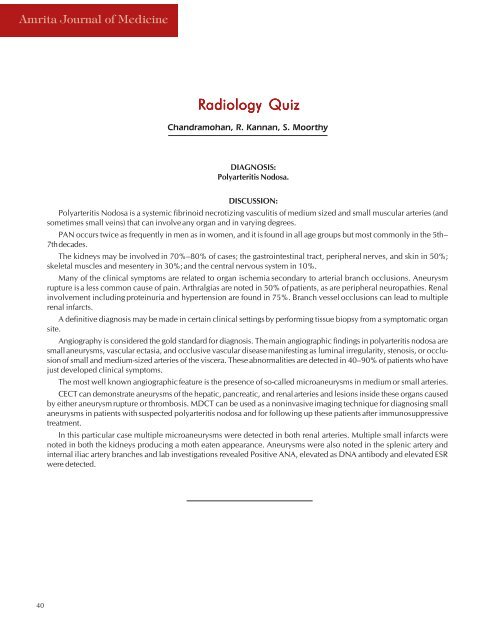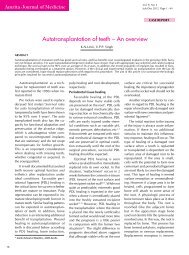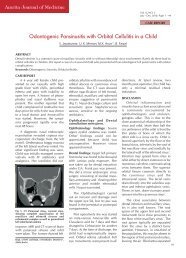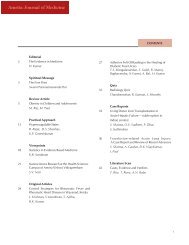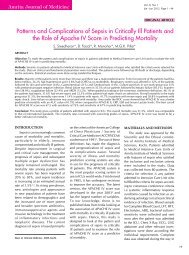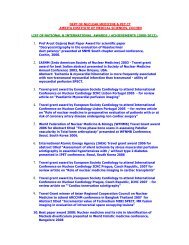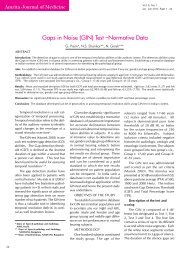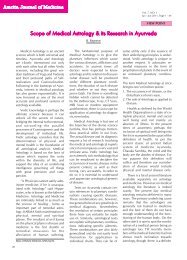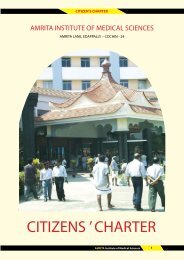Journal of Medicine Vol 4 - Amrita Institute of Medical Sciences and ...
Journal of Medicine Vol 4 - Amrita Institute of Medical Sciences and ...
Journal of Medicine Vol 4 - Amrita Institute of Medical Sciences and ...
Create successful ePaper yourself
Turn your PDF publications into a flip-book with our unique Google optimized e-Paper software.
<strong>Amrita</strong> <strong>Journal</strong> <strong>of</strong> <strong>Medicine</strong><br />
Radiology Quiz<br />
Ch<strong>and</strong>ramohan, R. Kannan, S. Moorthy<br />
DIAGNOSIS:<br />
Polyarteritis Nodosa.<br />
DISCUSSION:<br />
Polyarteritis Nodosa is a systemic fibrinoid necrotizing vasculitis <strong>of</strong> medium sized <strong>and</strong> small muscular arteries (<strong>and</strong><br />
sometimes small veins) that can involve any organ <strong>and</strong> in varying degrees.<br />
PAN occurs twice as frequently in men as in women, <strong>and</strong> it is found in all age groups but most commonly in the 5th–<br />
7th decades.<br />
The kidneys may be involved in 70%–80% <strong>of</strong> cases; the gastrointestinal tract, peripheral nerves, <strong>and</strong> skin in 50%;<br />
skeletal muscles <strong>and</strong> mesentery in 30%; <strong>and</strong> the central nervous system in 10%.<br />
Many <strong>of</strong> the clinical symptoms are related to organ ischemia secondary to arterial branch occlusions. Aneurysm<br />
rupture is a less common cause <strong>of</strong> pain. Arthralgias are noted in 50% <strong>of</strong> patients, as are peripheral neuropathies. Renal<br />
involvement including proteinuria <strong>and</strong> hypertension are found in 75%. Branch vessel occlusions can lead to multiple<br />
renal infarcts.<br />
A definitive diagnosis may be made in certain clinical settings by performing tissue biopsy from a symptomatic organ<br />
site.<br />
Angiography is considered the gold st<strong>and</strong>ard for diagnosis. The main angiographic findings in polyarteritis nodosa are<br />
small aneurysms, vascular ectasia, <strong>and</strong> occlusive vascular disease manifesting as luminal irregularity, stenosis, or occlusion<br />
<strong>of</strong> small <strong>and</strong> medium-sized arteries <strong>of</strong> the viscera. These abnormalities are detected in 40–90% <strong>of</strong> patients who have<br />
just developed clinical symptoms.<br />
The most well known angiographic feature is the presence <strong>of</strong> so-called microaneurysms in medium or small arteries.<br />
CECT can demonstrate aneurysms <strong>of</strong> the hepatic, pancreatic, <strong>and</strong> renal arteries <strong>and</strong> lesions inside these organs caused<br />
by either aneurysm rupture or thrombosis. MDCT can be used as a noninvasive imaging technique for diagnosing small<br />
aneurysms in patients with suspected polyarteritis nodosa <strong>and</strong> for following up these patients after immunosuppressive<br />
treatment.<br />
In this particular case multiple microaneurysms were detected in both renal arteries. Multiple small infarcts were<br />
noted in both the kidneys producing a moth eaten appearance. Aneurysms were also noted in the splenic artery <strong>and</strong><br />
internal iliac artery branches <strong>and</strong> lab investigations revealed Positive ANA, elevated as DNA antibody <strong>and</strong> elevated ESR<br />
were detected.<br />
40


